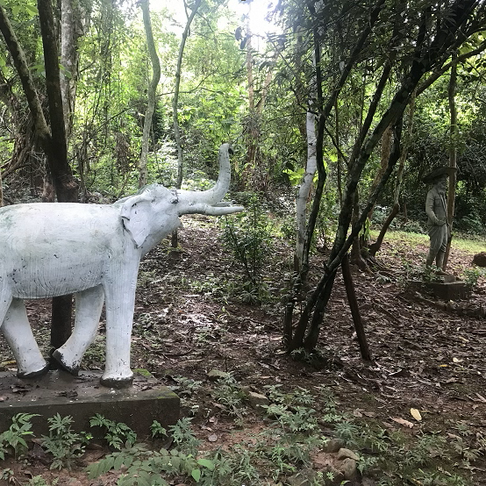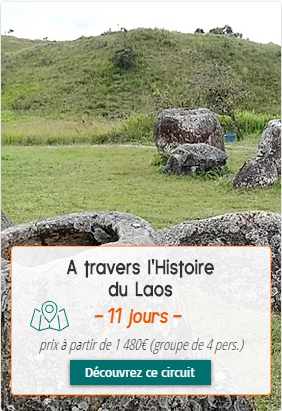Henri Mouhot, on the trail of his last adventure in Laos
Dernière mise à jour : 7 juil. 2023
Charly and Vasanath decided to visit Henri Mouhot at his grave (cenotaph or tomb, the subject is covered in the article) in Luang Prabang to explore this hidden treasure preserved by the town of Montbéliard since 1990.
The monument is located just 8km from the town center, on a country road heading south-east from Luang Prabang. It stands in a small forest, still wild and in the image of the adventurer. A statue of Auguste Pavie (not the statue of Henri Mouhot, as many people might think) was installed here in the 2000s, as well as a statue of an elephant, a reminder of the caravan of elephants that accompanied Henri Mouhot on his last expedition. When we visited the site, we had the strangest feeling. The warm, welcoming atmosphere led us to believe that there was still life in this very special place.
We thought it would be useful to devote an article to Henri Mouhot, as many of you have asked us to visit him when creating your tailor-made trip.
We leave you to enjoy the photos and the article that our team took pleasure in writing for you.
Happy reading!

In a nutshell, who is Henri Mouhot?
Henri Mouhot was born in Montbéliard in 1826. He is considered one of the greatest French explorers of his time. From an early age, he developed a taste for distant travels and, at 18, decided to leave for St. Petersburg to teach French at the Military Academy for 10 years. Following the Crimean War, he decided to return to France, where he married an Englishwoman who happened to be the niece of Munfo Park, the famous British explorer. In the middle of the 19th century, the French began to take a keen interest in exploring Indochina. So it was only natural that Henri Mouhot should turn his attention to Southeast Asia.
First trip to the "Kingdom of Siam" from April 27, 1858 to December 23, 1858.
Some extracts and stories from his travel diary:
"On April 27, 1858, I embarked in London on a sailing vessel of very modest appearance, to carry out the project I had been developing for some time, that of exploring the kingdoms of Siam, Cambodia and Laos and the tribes occupying the basin of the great Mekong River...".
On September 12, he decided to embark for Bangkok, for 4 months of sailing on troubled waters to begin his adventure. He was warmly welcomed by the king of the time, who gave him his permission and blessing to explore the country in all its nooks and crannies. Henri Mouhot was one of the first Westerners to rub shoulders with the country's inhabitants. He had the opportunity to familiarize himself with the local populations and their customs, as well as to perfect his knowledge of Asian flora and fauna.
En route to the Kingdom of Cambodia from December 23, 1858 to April 4, 1859
After a few months in the kingdom of Siam, Henri Mouhot realized that British influence was already well established, and decided to explore the neighboring kingdom of Cambodia. He set off in a simple fisherman's boat and arrived on the Cambodian shore at Kampot. As soon as he arrived in the harbor, he met the king who, as luck would have it, was visiting the south of the country. The king took note of Henri's intentions and promised him every assistance during his stay.
He then set off for the west of the country, attracted by rumors of a huge forgotten palace lost in the jungle, which might once have served as the capital. He decided to head up the great Tonlé-Sap lake and, after three days walking through the bush, was suddenly shocked!
* Quotes from his travel diary:
"Towards the 14th degree of latitude and the 102nd of longitude to the east of Paris, there are ruins so imposing, the fruit of such prodigious work, that on seeing them, one is seized with the deepest admiration and wonders what has become of the powerful, civilized and enlightened people, to whom these gigantic works could be attributed... One of these temples would stand with honor next to our most beautiful basilicas: It is more grandiose than anything ever built by the Greeks or Romans... A work of giants! ... Prodigious works of which the sight alone can give a fair idea, and in which the patience, strength and genius of man seem to have surpassed themselves in order to confound the imagination... But which Michelangelo of the East could have conceived such a work? ... "
He then set about inventorying the monument and representing it in all its forms, so as to make his work visible from Europe.
Can we say that Henri Mouhot was one of the first Westerners to discover the city of Angkor? With great conviction, we can!
En route to North Laos and discovery of Luang-Prabang (April 12 - November 10, 1861)
After discovering the city of Angkor, he decided to return to Bangkok to prepare his other major project, the discovery of Northern Laos.
After six weeks' navigation on the Mekong, he arrived in Paklay on June 24, 1861, and set off for Luang Prabang by elephant along the Paklay-Thadeua trail. Once he arrived in the kingdom, he fell in love with this "little town" (he estimated its population at the time at seven thousand). He even described it as a "little paradise" in his travel diary. He was naturally welcomed by the King of Luang Prabang, to whom he explained his desire to discover the valleys of the Nam Khan and Nam Ou rivers (discover our cruise on the Nam Ou).

Source French embassy in Laos.
Henri Mouhot's end came all too soon. His last accounts tell of the adventurer's first symptoms and headaches, linked to the diseases many of his fellow adventurers perished from during his expedition. In these regions of Northern Laos, and especially during the rainy season, dengue fever, malaria, bush typhus and other fevers still unknown to the learned world, inevitably resurface every year.
On October 15, in view of the increasingly severe symptoms, he decided to return to Luang Prabang as quickly as possible with his entire elephant caravan. It was on October 19, on his way back, that he wrote the words: "I'm suffering from fever". His last words were written around October 29, when he penned these last lines: "Have mercy on me, O my God!...". Then, on November 7, his condition worsened. He fell into a comatose state and died a few days later, on November 10, 1861, at the age of 35, of yellow fever, just 45 minutes by pirogue from Luang Prabang on the Nam Khan River.
He was buried close to where he died, near the village of Ban Phanom.
Cénotaphe (tombe vide commémorative) ou tombe, comment appeler ce monument?
Some experts maintain that between 1861 and 1866, it is likely that the explorer's body was swept away by a flood of the Nam Khan River.
As a result, we are unable to officially answer the question of what to call the funerary monument: "Is it a tomb with the explorer's remains or a cenotaph? The body may no longer be there, or it may not be in the location of the monument".
A little history:
Stories: History of Henri Mouhot's burial site and monument - Jean-Michel STROBINO
In 1863, with the support of Emperor Napoleon III, the then Minister of the Navy commissioned the Governor of Cochinchina, Admiral de La Grandière (1807-1876), to organize an expedition along the Mekong. This mission, christened the Commission d'Exploration du Mékong (Mekong Exploration Commission), was to carry out a systematic survey of the Mekong River, following as closely as possible the route taken by Henri
Mouhot. It would then attempt to go beyond the last point reached by Mouhot, and continue exploring the river and the countries it passed through as far as possible. Command of this mission was entrusted to Commander Ernest Doudart de Lagrée (1823-1868), assisted by Lieutenant Francis Garnier (1839-1873), the future hero of Tonkin.
It should be noted that Admiral de La Grandière advocated the construction of a monument, proof that by 1866 there were few illusions about the chances of finding the original tomb and remains intact, given the devastating effects of time and nature in these regions.contrées sauvages.
In 1867, in keeping with the instructions he had received from Admiral de La Grandière, Commandant Doudart de Lagrée commissioned the construction of the monument to Mouhot. Ensign Louis Delaporte (1842-1925), the expedition's official artist and documentalist, was entrusted with the task of creating and supervising the work.
The King himself agreed to help his French hosts by providing the necessary manpower and building materials:
"Mouhot's body was buried eight kilometers from Luang-Prabang, on the banks of the Nam-Khan, near the village of Naphao. I asked for permission to erect a modest monument over his grave, to attest to our homage and preserve his memory in the country. The King was most gracious in granting this request, and was willing to provide all the materials for the monument. I asked M. Delaporte to carry out the work, which consists of a brick masonry mass 1m80 long, 1m10 high and 0m80 wide. A stone framed on one side of the monument bears the name of Henri Mouhot and the date: 1867.
Attempt to excavate the site to find the remains.
So it was that Louis Delaporte (1842-1925), after a long search for the tomb buried under thick jungle, set out to rebuild it. Before proceeding, he wanted to excavate the site in an attempt to find the remains of his compatriot, so as to reconstruct the monument in the desired location. But the villagers objected, considering that an exhumation would offend the soul of the deceased.
The monument was rebuilt and inaugurated on May 10, 1867, but it was not known for certain whether the remains were actually there and/or in the precise location where they had been rebuilt.
"Delaporte was forced to give up, leaving the mystery of the explorer's presence
and exact location of the explorer's remains."
It was 20 years later, in 1887, that the appointed vice-consul representing French interests, Auguste Pavie (1847-1925), another explorer who had fallen under the spell of Luang Prabang, made his first visit to assess the state of the tomb. It was during his second visit in 1890 that he completely rebuilt the monument.
Henri Mouhot's story will live on in the memory of all those who have been and still are interested. From 1890 to the present day, the tomb has undergone numerous adventures and refurbishments.... It now benefits from permanent maintenance and remains a pleasant place of commemoration to visit for all those wishing to pay tribute to the first French explorer to discover Luang Prabang.
The ORLA TOURS team was keen to pay this visit to the grave of one of our illustrious compatriots, to honor his memory and pay tribute to his work and discoveries.
You too can discover Laos by contacting Phasouk, Charly or Vasanath, your Luang Prabang-based tailor-made travel experts.
Playful video of our arrival at the site to pay tribute to Henri Mouhot
For those of you who, like us, would like to know more about his adventures and read his travel diary in full, here's the link to the original Ebook version.
Here are some other links that might interest you:
#HenriMouhot #voyageluangprabang #explorateurfrancais #voyagelaos #hommage #découverte #luangprabang #amoureuxdecetteville #rivierenamkhan #namou #expédition #aventurier #horsdessentiersbattus #découverte #aventures #laos #asie













